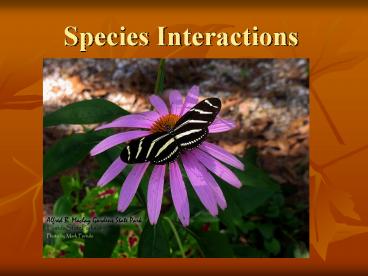Species Interactions - PowerPoint PPT Presentation
1 / 11
Title:
Species Interactions
Description:
Ecological niche the role played by a species in a biological ... Keystone set otters/kelp/sea urchins. http://www.bullfrogfilms.com/photos/nat3image.jpg ... – PowerPoint PPT presentation
Number of Views:213
Avg rating:3.0/5.0
Title: Species Interactions
1
Species Interactions
2
Habitat vs. Niche
- Habitat the place or set of environmental
conditions in which a particular organism lives. - Ecological niche the role played by a species
in a biological community or the total set of
environmental factors that determine species
distribution
3
Charles Elton, 1927
- Niches as community roles
- Describes how a species obtains food
- What relationships it has with other species
- Services it provides its community
http//www.dmclf.net/pics/predators-seal-crested.j
pg
4
G.E. Hutchinson
- Biophysical definition
- Range of physical and chemical conditions
(temperature, light levels, acidity, humidity,
salinity, etc.) - Biological interactions (predators and prey
present, defenses, nutritional resources
available, etc.)
5
Generalists vs. Specialists
- Raccoons or coyotes eat a wide variety of food
and live in a broad range of habitats.
(Generalists) - Panda occupy a very narrow niche. (Specialist)
http//www.uszanders.com/Photo20Collection/slides
/15PH20Raccoons.jpg
6
Law of Competitive Exclusion
- No two species will occupy the same niche and
compete or exactly the same resources in the same
habitat for very long. - Niche specialization can create behavioral
separation that allows subpopulations of a single
species to diverge into separate species.
http//www.aidsmemorial.org/competition/images/pic
_home.jpg
7
Predators and parasites prey on other organisms
- Predator an organism that feeds directly upon
another living organism, whether or not it kills
the prey to do so. - Herbivores, carnivores, and omnivores are
predators - Scavengers, detritivores, and decomposers that
feed on dead things are not. - Predators prey most successfully on the slowest,
weakest, least fit members of their target
population.
8
Predators and parasites prey on other organisms
- Coevolution process in which species exert
selective pressure on each other. - Parasites are organisms that feed on a host, or
take resources from it, without killing the host.
- Pathogens disease-causing organisms (immune
system is an evolved defense against pathogens in
our environment)
http//elementy.ru/images/eltbook/coevolution.jpg
9
Keystone Species
- A species or group of species whose impacts on a
community are much larger than would be expected
from more abundance. - Wolves, certain tropical figs, mycorrhizae (fungi
associated with tree roots) - Keystone set otters/kelp/sea urchins
http//www.bullfrogfilms.com/photos/nat3image.jpg
10
Competition
- Intraspecific competition competition among
members of the same species (Limited by life
cycles, shading, etc.) - Interspecific competition competition between
members of different species (weeds) - Territoriality intense form of intraspecific
competition in which organisms define an area
surrounding their home site or nesting site and
defend it primarily against other members of
their own species
http//elementy.ru/images/eltbook/animal_territori
ality720.jpg
11
Symbiosis
- Intimate living together of members of two or
more species - Commensalism one member benefits and the other
is not substantially benefited or harmed. - Mutualism both members of the partnership
benefit
http//en.wikipedia.org/wiki/Goby































